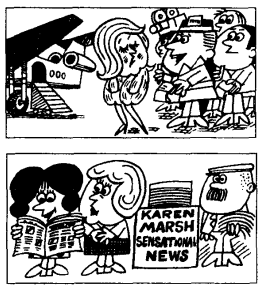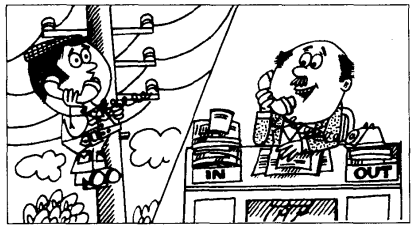one|Lesson 131~140
Lesson 131~132
✨课文

✨单词
⚡本课重点
may和might:表示对过去、现在、将来的推测,概率不高,50%左右,意思为「可能、也许」。其否定形式为在may/might的后面直接加not
虽然might本身是may的过去式,但在现代英语使用习惯中,might同样能用来对当前或将来状况进行推测,只是其概率比may稍低,并且当情况是虚拟的时候只能用might。
对现在或将来推测
may/might (not)+V.e.g. He may know the answer.、We might not go anywhere.
may/might (not) be+adj./n.e.g. They may be busy.、She might not be a teacher.
may/might (not) be+V.inge.g. You may not be joking.、They might be having lunch.
对过去推测
may/might (not) have+V.pp.e.g. He may have known the answer.、We might not have gone anywhere.
may/might (not) have been+adj./n.e.g. They may not have been busy.、She might have been a teacher.
may/might (not) have been+V.inge.g. You may have been joking.、They might not have been having lunch.
might have been连读:发音为/ˈmaɪt həv biːn/,h不发音
Lesson 133~134
✨课文

✨单词
直接引语变间接引语
⚡本课重点
在之前的75~76课和99~100课中,主要学习了宾语从句在主句是一般现在时的用法,这时候的从句可以是任何时态
当主句是一般过去时情况下,间接引语通常需要改变人称和时态,这是因为原话进行的时间永远都是早于转述的时间
直接引语变间接引语
| 人称变化 | 说明 | 直接引语 | 间接引语 | ||
|---|---|---|---|---|---|
| 时态 | 例句 | 时态 | 例句 | ||
| 一随主 | 引号内第一人称变间接引语后,与主句主语的人称保持一致 | 一般现在时 | She said, "I like English." | 一般过去时 | She said she liked English. |
| 现在进行时 | She said, "I am studying English." | 过去进行时 | She said she was studying English. | ||
| 现在完成时 | They said, "We have finished the work." | 过去完成时 | They said they had finished the work. | ||
| 一般过去时 | He said to her, "I waited for an hour." | He told her that he had waited for an hour." | |||
| 一般将来时 | She said, "I am going to study English." | 过去将来时 | She said she was going to study English. | ||
| 二随宾 | 引号内第二人称变间接引语后,与主句宾语的人称保持一致,如果主句没有宾语,则可以用第一人称 | 一般现在时 | Tom said to Lucy, "You are so cute." | 一般过去时 | Tom told Lucy she was so cute. |
| 现在进行时 | The policeman said, "You are driving too fast." | 过去进行时 | The policeman said I was driving too fast. | ||
| 现在完成时 | She said to him, "You have finished your job." | 过去完成时 | She told him that he had finished his job. | ||
| 一般过去时 | She said to him, "You did very well." | She told him that he had done very well. | |||
| 一般将来时 | She said to me, "I am going to buy you an ice cream." | 过去将来时 | She told me that she was going to buy me an ice cream. | ||
| 第三人称不更新 | 引号内第三人称变间接引语后,人称保持不变 | 一般现在时 | She said to me, "Tom is the winner." | 一般过去时 | She told me that Tom was the winner. |
| 现在进行时 | He said, "She is waiting for a bus." | 过去进行时 | He said that she was waiting for a bus. | ||
| 现在完成时 | He said to me, "They have already retired." | 过去完成时 | He told me that they had already retired. | ||
| 一般过去时 | She said to me, "Jack bought a new car." | She told me that Jack had bought a new car. | |||
| 一般将来时 | She said to me, "They are going to move into a new flat." | 过去将来时 | She told me that they were going to move into a new flat. | ||
Lesson 135~136
✨课文

✨单词
⚡本课重点
let:表示「允许、让」。它与一般动词不同,使用结构为 let+名词/代词+V.,其中V表示不带to的动词不定式
- e.g. She lets her son play in the garden.
introduce A to B:表示「把A介绍给B」
- e.g. He introduces me to his friend.
当主句是一般过去时情况下,间接引语中的情态动词要用过去式
| 人称变化 | 说明 | 直接引语 | 间接引语 | ||||
|---|---|---|---|---|---|---|---|
| 时态 | 情态动词 | 例句 | 时态 | 情态动词 | 例句 | ||
| 一随主 | 引号内第一人称变间接引语后,与主句主语的人称保持一致 | 一般现在时 | can | She said, "I can speak English." | 一般过去时 | could | She said she could speak English. |
| will | He said, "I will do it myself." | would | He said he would do it himself. | ||||
| may | He said, "I may go with you." | might | He said he might go with me. | ||||
| 二随宾 | 引号内第二人称变间接引语后,与主句宾语的人称保持一致,如果主句没有宾语,则可以用第一人称 | 一般现在时 | can | His mother said, "You can watch television." | 一般过去时 | could | His mother said that he could watch television. |
| will | He said, "You will win." | would | He said that I would win. | ||||
| may | He said to her, "You may be right." | might | He told her that she might be right. | ||||
| 第三人称不更新 | 引号内第三人称变间接引语后,人称保持不变 | 一般现在时 | can | She said to me, "Tom can swim." | 一般过去时 | could | She told me that Tom could swim. |
| will | She said, "They will go to London next week." | would | She said that they would go to London next week. | ||||
| may | He said to me, "She may be 18." | might | He told me that she might be 18. | ||||
Lesson 137~138
✨课文

✨单词
条件从句
⚡本课重点
if:单词本义「如果、是否」,通常用来引导一个从句
条件从句:如果我们认为将来的事件是可能发生的,就可以用if条件从句去描述将会发生什么事或不会发生什么事。其基本结构为 if+一般现在时+将来时/情态助动词。也就是主句用将来时或情态动词,从句用一般现在时,归纳为四字诀「主将从现」
如果if条件从句是前半句的话,常常需要用逗号分隔;而如果是后半句的话则不需要用逗号分隔
- If it rains tomorrow, we won't go to the seaside.
- I'll wash the dishes if you cook dinner.
- If you're have enough money, you can buy a big house.
Lesson 139~140
✨课文

✨单词
疑问句宾语从句
⚡本课重点
在之前的75~76课、99~100课和133~136课中所学的宾语从句全部都是陈述句做宾语从句,本节课将会学习疑问句做宾语从句的相关知识
| 连接词 | 宾语从句 | |
|---|---|---|
| 主句 | that,可省略 | 陈述句 (肯&否) |
if,不可省略 | 一般疑问句 (陈述语序) | |
特殊疑问词,不可省略 | 特殊疑问句 (陈述语序) |
一般疑问句宾语从句:由 if引导的陈述语序的一般疑问句作宾语从句,其结构为 主句+if+宾从(一般疑问句)
看下面几个例子,掌握一般疑问句宾语从句的转化步骤
e.g. I want to know ...
- ①一般疑问句:Is she a teacher?
- ②把一般疑问句转为陈述语序:she is a teacher.
- ③给主句添加连接词
if用来引导第二步的陈述语序:I want to know if she is a teacher.
- ①一般疑问句:Does she often go shopping?
- ②把一般疑问句转为陈述语序:she often goes shopping.
- ③给主句添加连接词
if用来引导第二步的陈述语序:I want to know if she often goes shopping.
- ①一般疑问句:Have you lost your key?
- ②把一般疑问句转为陈述语序:you have lost your key.
- ③给主句添加连接词
if用来引导第二步的陈述语序:I want to know if you have lost your key.
- ①一般疑问句:Will you go to school tomorrow?
- ②把一般疑问句转为陈述语序:you will go to school tomorrow.
- ③给主句添加连接词
if用来引导第二步的陈述语序:I want to know if you will go to school tomorrow.
特殊疑问句宾语从句:由 特殊疑问词引导的陈述语序的特殊疑问句作宾语从句,其结构为 主句+特殊疑问词+宾从(特殊疑问句)
看下面几个例子,掌握特殊疑问句宾语从句的转化步骤
e.g. He wants to know ...
- ①特殊疑问句:What's your job?
- ②句首的特殊疑词将作为引导词维持不动,把其后面的部分转为陈述语序,人称代词根据语义进行调整:what my job is.
- ③将第二步得到的以特殊疑问词引导的陈述语序拼接到主句上:He wants to know what my job is.
- ①特殊疑问句:When is she going to have a bath?
- ②句首的特殊疑词将作为引导词维持不动,把其后面的部分转为陈述语序:when she is going to have a bath.
- ③将第二步得到的以特殊疑问词引导的陈述语序拼接到主句上:He wants to know when she is going to have a bath.
- ①特殊疑问句:Why does she want to see you?
- ②句首的特殊疑词将作为引导词维持不动,把其后面的部分转为陈述语序,人称代词根据语义进行调整:why she wants to see me.
- ③将第二步得到的以特殊疑问词引导的陈述语序拼接到主句上:He wants to know why she wants to see me.
- ①特殊疑问句:Why didn't you clean the car?
- ②句首的特殊疑词将作为引导词维持不动,把其后面的部分转为陈述语序,人称代词根据语义进行调整:why I didn't clean the car.
- ③将第二步得到的以特殊疑问词引导的陈述语序拼接到主句上:He wants to know why I didn't clean the car.
- ①特殊疑问句:How long have you lived in Nanning?
- ②句首的特殊疑词将作为引导词维持不动,把其后面的部分转为陈述语序:how long I have lived in Nanning.
- ③将第二步得到的以特殊疑问词引导的陈述语序拼接到主句上:He wants to know how long I have lived in Nanning.